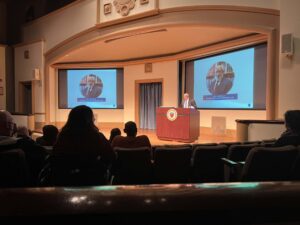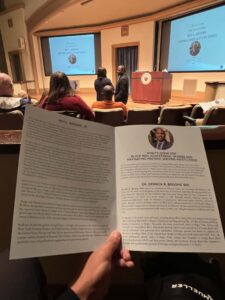I will be writing my blog about the “Black Present and Presence – Ubiquitous Black Ideologies & Conceptions of Art” Lecture presented by Dr. Susie Bhaka (Department of Theology and Religious Studies at University of San Diego), and Dr. Corey Barnes (Department of Philosophy at University of San Diego). This lecture aimed to highlight historical African American communal traditions, ideologies, and arts practiced throughout recent history. Doctrines discussed in this lecture allow us to deeply analyze, empathize with, provide insight and detail to, and better understand African American History.
One of the Main topics from the lecture was the Black Aesthetic Experience. The Black Aesthetic Experience is a term used to describe the cultural and artistic expressions of black people throughout history. It encompasses a wide range of creative practices, including literature, music, visual art, theater, dance, and film, and is rooted in the historical experiences of black people. One example of the Black Aesthetic discussed in the lecture described in detail how black people on slave ships would cut each other’s hair in order to maintain a certain look. According to John Gabriel Stedman who was a white oppressionist aboard one of these slave ships, “All slaves are led upon deck, where they are examined by the purchasers, who are very attentive to their persons. Here they are also separated from their companions and relations, with whom they had been brought on board. The next step is to shave off all the hair from their heads…, their hair being made into different figures, such as stars, half-moons, etc. which they generally do one to the other, having no razors, by the help of a broken bottle, and without soap”. Even without the proper equipment and in extremely poor living conditions, the black people still made it a priority to cut their hair and preserve their cultural aesthetic. This dedication conveys how important cultural practices and expressing themselves was to them. A quote from The Birth of American-American Culture: An Anthropological Perspective by Sidney Mintz and Richard Price, summed this up perfectly. It reads, “It is hard to imagine a more impressive example of irrepressible cultural vitality than this image of slaves decorating one another’s hair in the midst of one of the most dehumanizing experiences in all of history”. This goes to show the resilience and creativity of enslaved people that showed through even in the face of extreme oppression.
Another main topic in the lecture was ubiquitous cultural vitality that was practiced in everyday life for African Americans. An important artistic part of this culture was song and dance. An example of the artistic practices highlighted in the video was something called the “Ring Shout”. The Ring shout involves a group of people moving in a circular motion while singing and dancing to music being played. The participants would frequently be dressed in all white and “moved counterclockwise while shuffling their feet, clapping, singing, calling out, or praying aloud.”(FOMM 370) Africans who practiced the ring shout were able to uphold their cultural customs and proclaim their religious beliefs. Though Ring Shout proves to be a good example of a specific artistic cultural practice, zooming out, The significance of singing and dancing as a whole was extremely important to black people. It served as an outlet for expression and a release of suppressed feelings. Slaves could express their pleasure, sadness, hope, and anguish through song and dance in a therapeutic and liberating way. Additionally, it contributed to the development of a sense of camaraderie and solidarity among slaves, who frequently felt alone and alienated throughout their captivity. It also served as a form of resistance against their masters. Many of the songs and dances included cryptic undertones and secret meanings that alluded to the longing for independence and the optimism for a brighter future that provided them with the hope they needed to keep going. Slaves may speak with one another without their masters hearing them by singing and dancing together. Not to mention, song and dance allowed African Americans to teach, practice, and preserve cultural traditions for generations to come. A quote included in the lecture that describes how powerful black music was states, “Black music is not artistic creation for its own sake, rather it tells us about the thinking and feeling of the African People, and the kinds of mental adjustments they had to make in order to survive in an alien land. The work songs were a means of heightening energy, converting labor into dances and games. Providing emotional excitement in an otherwise unbearable situation. The emphasis was on free continuous creative energy as produced in song.”(James Cone).
The last main topic from the lecture was the contrast between black aesthetics and white aesthetics. In the last few hundred years in America, beauty and art have been looked upon using the “white yardstick of civilization”(Bell Hooks). Essentially, what was thought of as beautiful or valuable art was determined by white people and toward other white people. The black aesthetic valued the beauty of imperfections, the roughness of the unpolished, and the authenticity of raw emotion, whereas the white aesthetic frequently favored formal beauty and idealized portrayals of reality. The white aesthetic tended to be more independent and secular in character, whereas the black aesthetic was frequently deeply linked to social and spiritual experiences. This gap between what both races valued was large and resulted in the dominant white majority completely disregarding black art as a form of art, just because it was different than what the whites were used to. According to Cornel West, “The authority of science, undergirded by modern philosophical discourse, promotes and encourages activities of observing, comparing, measuring, and ordering the physical characteristics of human bodies. Forms of rationality and science prohibited the legitimacy of black equality and beauty culture and intellectual capacity to think about black and white equally was deemed irrational, barbaric or mad”. Another similar quote by Bell Hooks from the lecture reads, “art in black communities intrinsically serves a political function. Whatever African Americans in music, dance, poetry, painting, was regarded as a testimony bearing witness challenging racist thinking which suggested that black folks are not fully human, were uncivilized, and that the measure of this was our collective failure to create great art”. These quotes provide an idea of how oppressed black art and the black aesthetic was in society. Despite extreme oppression in pretty much all facets of life, black people continued to practice their artistic culture or aesthetic and didn’t let the attitude of the masses stop them. Ultimately the difference between the black aesthetic and white aesthetic is significant in understanding the historical context of how white supremacy shaped the dominant cultural narratives and aesthetics in America, while also recognizing the resilience and creativity of black people in the face of systemic oppression.
In conclusion, the lecture on “Black Present and Presence – Ubiquitous Black Ideologies & Conceptions of Art” presented by Dr. Susie Bhaka and Dr. Corey Barnes sheds light on the historical and cultural significance of the Black Aesthetic Experience, the ubiquitous cultural vitality of everyday life for African Americans, and the contrast between black aesthetics and white aesthetics. By examining these topics, we can gain a better understanding of the resilience, creativity, and cultural vitality of black people, who were able to preserve their cultural traditions and express their feelings through art, despite facing systemic oppression which ultimately gives us a better opportunity to understand and empathize with African American history as a whole. It is essential to acknowledge the value of the black aesthetic as a unique and significant artistic expression that deserves recognition and respect in its own right. Furthermore, we must continue to learn about and appreciate the cultural contributions of black people, as we strive towards a more equitable and just society.




